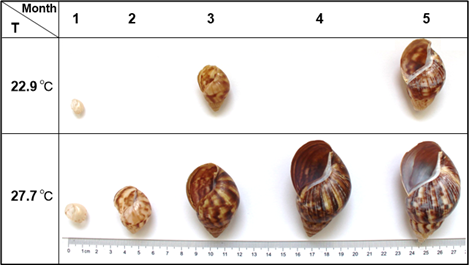Quantitatively reconstructing temperature changes is vital to understand the history and law of the Earth's climate system.
Land snails are widely distributed, and the clumped isotope (Δ47) in their shell carbonates can serve as a proxy for temperature in terrestrial environments. However, it is unclear whether the Δ47 values of snail shells are affected by biological processes known as "vital effects".
Researchers from the Institute of Earth Environment of the Chinese Academy of Sciences and Caltech cultured land snails at different well-controlled temperatures. They collected snail shells from different species at different growth age, and reported their Δ47 values.
This study was published in Palaeogeography, Palaeoclimatology, Palaeoecology.
The researchers found that there were no significant differences in the Δ47 values of different species, indicating no influences of species. The good correlation between snail shell's Δ47 and their growth temperature suggested its potential for temperature reconstruction.
When applied the previously established Δ47-temperature transfer function, the mean reconstructed temperature is ~6 °C higher than snail culturing temperatures. This indicated the existence of the vital effect in land snail shells.
Furthermore, the researchers found that this effect could be corrected by establishing a new Δ47-temperature transfer function.
The study provided a valuable dataset for building Δ47-temperature transfer function for land snails and it also served as a good foundation for past temperature study using fossil snail shells in the near future.

Fig. Cultured A. fulica “white” snail shells at different temperatures from different month ages (Image by DONG, et)
Contact: Bai Jie, Institute of Earth Environment, Chinese Academy of Sciences, Xi'an, China. Email: baijie@ieecas.cn
 © 2015 Institute of Earth Environment,CAS
© 2015 Institute of Earth Environment,CAS Address:No. 97 Yanxiang Road, Xi'an 710061, Shaanxi, China

 Location :
Location :